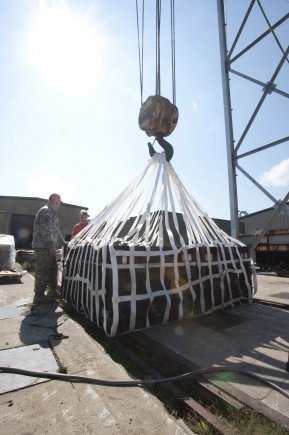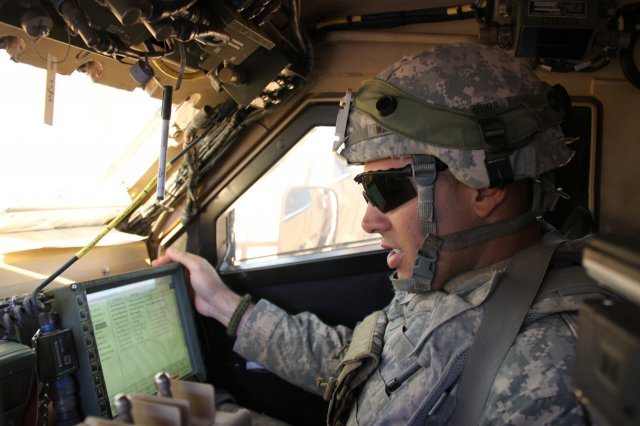Everyone knows that without water and fuel, the modern Army would grind to a halt in the field.
Throughout military history, the challenge has been to deliver enough of those two precious commodities to the front lines to keep Soldiers moving. That continues to be an issue today in Afghanistan, where unforgiving terrain, weather, political conditions and the enemy can disrupt the flow of supplies.
Most often, fuel and water are delivered in 55-gallon drums or 500-gallon blivets by aircraft or convoy. These containers are cumbersome, and they take up too much space at small forward operating bases.
“Resupply of fuel and water is always a concern,” said Dave Roy, a current operations analyst with the Quick Reaction Cell at Natick Soldier Research, Development and Engineering Center, or NSRDEC. “Having to rely on a combat logistics patrol can be nerve-wracking at times, not just because those convoys are targets of insurgent activity.
“The environment and the terrain those convoys have to go over is like ‘Ice Road Truckers’ on steroids. These are the world’s most deadly roads.”
Roy added that, once the water and fuel arrive, the next problem is returning empty containers.
“Some of the challenges include having enough containers at the logistical supply points to refill with fuel, primarily, and water. The ability to transport product economically to its final destination; and being able to retrograde all of the empty containers back to the rear for reuse,” Roy said. “We can’t prioritize combat logistic patrols to take back empty 55-gallon drums. They take up too much room, and it’s just not priority cargo.”
A new system promises a more reliable, cost-effective way to transport the vital liquids in sufficient quantities without worrying about retrieving expensive equipment used in the delivery process. The Container Unitized Bulk Equipment system, or CUBE, allows for delivery by helicopter sling load, airdrop or ground transport.
The CUBE system contains a low-cost helicopter sling-load net, two crate-like, plastic containers, and two fuel blivets or water bladders. The CUBE is expected to cut costs by 50 percent, and the stackable, collapsible system would take up less space on FOBs and be easier to transport back to logistics bases. Once the liquid products are dispensed, the crates can be re-purposed to provide the forward location with additional storage and transport containers.
As Roy pointed out, the CUBE system is a combination of items already in the government procurement system and off-the-shelf commercial items.
“There is a lot of low-hanging fruit that can be harvested simply by taking those components that would not normally have been thought could go together and nesting them together,” Roy said. “Crazy ideas that work are not crazy. Really, it’s just being able to leverage strength through technology. There’s a big payoff at the end for the entire force.”
The need was identified in 2010 as the 101st Sustainment Brigade prepared for its deployment to Afghanistan. The Warfighter Protection & Aerial Delivery Directorate at NSRDEC, with John Mahon as the project lead, responded with a prototype of the CUBE. The 101st SB took a number of the systems with them.
Since deploying, the 101st SB has funded and received, through NSRDEC, more than 100 systems with the primary bladder used to support fuel transportation. This system allowed the pre-positioning of fuel in anticipation of adverse weather at the most remote FOBs.
“The unit deploys to Afghanistan in September of 2010,” Roy recalled. “While they’re there, they’re constantly calling back (and saying), ‘Hey, we want some more of that stuff.'”
Roy and the QRC got involved. Now, seven CUBE units — four for fuel, three for water — are scheduled for delivery to the Combined Joint Special Operations Task Force-Afghanistan by the end of 2011.
“We’re very close to delivery,” Roy said. “Developmental Test Command has provided a System Safety Confirmation, and we are on schedule to have the seven CUBE kits delivered from Peckham, an AbilityOne source, to the RDECOM Forward Assistance Science & Technology — Center in Bagram, Afghanistan, in December.
“We’re positioned now for a forward operational assessment of this capability by Army Test and Evaluation Command in Afghanistan in second quarter of this year. It’s of interest across the force.”
The NSRDEC QRC has collaborated with Tank-Automotive and Armaments Command, or TACOM, Integrated Logistics Support Center Soldier-Product Support Integration Directorate to develop a locally produced Interim Technical Document that provides the basic functions of a technical manual.
National Stock Numbers have been secured for each CUBE kit, as well (NSN: 1670-01-598-5071 — Fuel, Container Unitized Bulk Equipment/NSN: 1670-01-598-5067 — Water, Container Unitized Bulk Equipment).
Roy believes the system will prove useful for government agencies beyond the Department of Defense.
“This has application for humanitarian missions executed by DOD, Department of State, and Department of Homeland Security, as well as the potential to support U.S. Forest Service and Bureau of Land Management,” said Roy, adding that it’s a matter of transferring “this technology to make the maximum effective use of taxpayer dollars — not just for Army or DOD use — but across the full spectrum of the government so that the taxpayers get the biggest benefit for our investment.”











